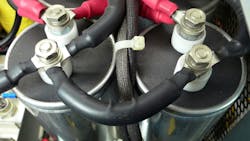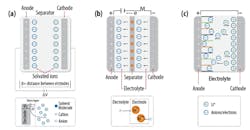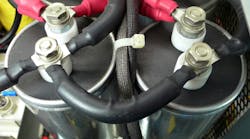The Unique Advantages of High-Power-Density Supercapacitors
What you'll learn:
- Difference between a conventional capacitor and a double-layer supercapacitor.
- Types of supercapacitors.
- How supercapacitors fare with respect to power density.
Supercapacitors possess a high cycle efficiency (more than a million cycles), a large number of charging cycles higher than 95%, and a faster discharge time with a longer life. The high value of a supercapacitor is usually measured in farads as compared to other capacitors, which are measured in microfarads or nanofarads.
Supercapacitors can be used in a range of applications from a battery alternative in uninterruptible power supplies (UPS) to improving linear voltage regulator operation.
What’s the Difference Between Capacitors and Supercapacitors?
Capacitors are excellent as energy-storage devices. Take an electric double-layer capacitor that’s able to store more charge or energy than standard capacitors. This unique device enables the plates used in the capacitor, which have a larger surface area and a shorter distance between the plates as compared to standard capacitors. Because of the high stored charge, these capacitors are uniquely known as supercapacitors.
Supercapacitor construction has two metal plates that consist of porous material like activated charcoal or carbon. No separate dielectric is utilized in a supercapacitor. The metal plates get soaked in an electrolyte and then separated via a thin insulator made out of carbon or paper.
The high surface area of the electrode along with a relatively thinner dielectric medium will result in the storage of a high charge within less space. When the plates reach a full charge, an opposite charge will form on either side of the dielectric, thus creating an electric double layer.
Supercapacitors are employed in applications such as power conditioning, industrial lasers, medical equipment, UPS, wireless communication systems, and wind turbines. Supercapacitors can be connected in series to produce higher voltages for more powerful equipment.
Kinds of Supercapacitors
Supercapacitors divide into three categories based on their charge storing mechanism: electrochemical double-layer capacitors, pseudo-capacitors, and hybrid electrochemical capacitors (see figure).
Supercapacitors have emerged over a few decades from an intriguing, preferred design choice to a consistently relied on technology for applications that span from battery backups to preventing unintended storage memory loss. Engineers are drawn to supercapacitors due to their multiple benefits, which includes excellent reliability and performance.
An important supercapacitor characteristic is that it can be charged and discharged virtually hundreds of thousands of times under normal conditions. Electrochemical batteries differ from supercapacitor batteries in that they have a defined cycle life; however, wear and tear remains low by cycling the supercapacitor. In addition, supercapacitors offer faster charge/discharge cycles than batteries, and they maintain effective current-handling capability.
>>Download the PDF of this article, and check out the Series Library for similar articles and videos
Power Density and Supercapacitors
Supercapacitor high power density leads to fast charge and discharge cycles, which makes possible fast energy bursts. These electrochemical capacitors can bridge the gap between batteries and traditional capacitors, having unique advantages in energy storage of power (i.e., energy per unit time) that enables a device to deliver relative to its weight or size.
Main features of supercapacitors include:
- High power density: Supercapacitors reach power densities significantly higher than that of conventional batteries, allowing them to quickly deliver energy. This trait is quite useful in applications such as power backup systems and regenerative braking in electric vehicles.
- Energy density: Although supercapacitors will excel in power density, they range between 30 to 50 Wh/kg in advanced designs. This is lower than batteries, but ongoing research will lead to enhancing these figures.
- Construction and materials: Supercapacitor power density is influenced by their construction, as well as the choice of electrode materials (such as carbon nanotubes and graphene) and the proper electrolyte.
The Future of Supercapacitors in Applications
Research efforts today focus on progressive performance metrics through the use of new materials and solid structural designs. The evolution of nanotechnology and advanced nanomaterials such as metal-organic frameworks (MOFs) holds considerable promise in terms of available surface area for charge storage.
In addition, manufacturing processes aimed at producing supercapacitors with reduced environmental impact while maintaining efficiency are under development. As technologies converge and mature, it’s anticipated that supercapacitors will continue to carve out a unique niche within the energy space, demonstrating access to high-performance energy storage solutions for both industries and consumers. One example is the development of supercapacitors that can be made from low-cost wearables.
References
1. “A Brief Review of Supercapacitors: Comparison with Traditional Capacitor and Batteries, their Types, and Fabrication Processes,” Sanjay M. Hundiwale, Dr. Shripad P. Mohani, Dr. D.J. Shirale, Proceedings of the 3rd International Conference on Self Sustainable Artificial Intelligence Systems (ICSSAS-2025) IEEE Xplore Part Number: CFP25DN7-ART; ISBN: 979-8-3315-3884-2, IEEE 2025.
2. “Supercapacitors: Overcoming current limitations and charting the course for next-generation energy storage,” Humaira Rashid Khan, Abdul Latif Ahmad, ScienceDirect/Elsevier, Version of Record, 3 December 2024.
3. “Shedding Light on Little-Known Power Density Applications,” Steve Taranovich, Electronic Design, June 2024.
4. Lecture 14: “The Electrical Double Layer (EDL), Nano mechanics of Materials and Biomaterials,” Thursday 04/05/07, Prof. C. Ortiz, MIT-DMSE.
5. “Enhancement of electrochemical and cyclic properties of carbon fiber supercapacitors coated with vanadium pentoxide and activated carbon,” Xin Xu, Zheng Zhang, Jing Wang, Heng Zhou, Xingrong Zhu, Yang Liu, Qi Wu, Kang Yan, Jinsong Liu, Hao Dong, Laifa Shen, Kongjun Zhu, Journal of Power Sources, Volume 658, December 2025.
6. “Modeling the Gouy−Chapman Diffuse Capacitance with Attractive Ion−Surface Interaction,” Katharina Doblhoff-Dier and Marc T. M. Koper.
7. “High power density supercapacitor, using a fast ion conducting, flexible, economical, and environment benign polymer-in-salt-electrolytes (PISEs),” Dipti Yadav, Neelam Srivastava, Department of Physics (MMV Section), Banaras Hindu University, Varanasi, 221005, India, Journal of Power Sources, Volume 647, 15 August 2025, 237353, India.
8. “Enhancing Vanadium Pentoxide-based (V2O5) cathodes for high-performance aqueous zinc-ion batteries: optimization of interlayer spacing, ion kinetics, voltage window,” Patient D. Nzengu, Ntuthuko W. Hlongwa, Kutloano E. Sekhosana, and Mesfin A. Kebede.
9. “Supercapacitors: An Emerging Energy Storage System,” Muhammad Faisal Iqbal, Farooq Nasir, Fiza Shabbir, Zaheer Ud Din Babar, Muhammad Farooq Saleem, Kaleem Ullah, Nana Sun, Faizan Ali, 13 March 2025.
10. "EV batteries could last much longer thanks to new capacitor with 19-times higher energy density that scientists created by mistake," Rory Bathgate, ITPro, May 8, 2024.
11. “A comprehensive review of supercapacitors: Properties, electrodes, electrolytes and thermal management systems based on phase change materials,” Xiyue He, Xuelai Zhang, Journal of Energy Storage, Volume 56, Part C, 15 December 2022, ScienceDirect.
12. “Understanding supercapacitors and their applications,” Arrow Electronics, 15 January 2024.
13. “How much energy can a supercapacitor store at most?,” NenPower, May 13, 2024.
14. Technology Strategy Assessment, Findings from Storage Innovations 2030, Supercapacitors, ENERGY, earthshots, U.S. Department of Energy, Storage, July 2023.
>>Download the PDF of this article, and check out the Series Library for similar articles and videos
About the Author

Steve Taranovich
Freelance Technical Writer, Phoenix Information Communication LLC
Steve is a contributing editor to Electronic Design.
Author of the non-fiction “Guardians of the Right Stuff,” a true story of the Apollo program as told by NASA and Grumman Corp. engineers, an astronaut, and technicians.
Experienced Editor-In-Chief of EETimes/Planet Analog and Senior Technical Editor at EDN running the Analog and Power Management Design Centers from 2012 to 2019.
A demonstrated history in electronic circuit design and applications for 40 years, and nine years of technical writing and editing in industry. Skilled in Analog Electronics, Space-related Electronics, Audio, RF & Communications, Power Management, Electrical Engineering, and Integrated Circuits (IC).
1972 to 1988 worked as a circuit design engineer in audio (8 years) and microwave (8 years). Then was Corporate Account Manager/applications engineer for Burr-Brown from 1988 to 2000 when TI purchased Burr-Brown. Worked for TI from 2000 to 2011.
Strong media and communication professional with a BEEE from NYU Engineering in 1972 and an MSEE from Polytechnic University in 1989. Senior Lifetime member of IEEE. Former IEEE Long Island, NY Director of Educational Activities. Eta Kappa Nu EE honor society member since 1970.


